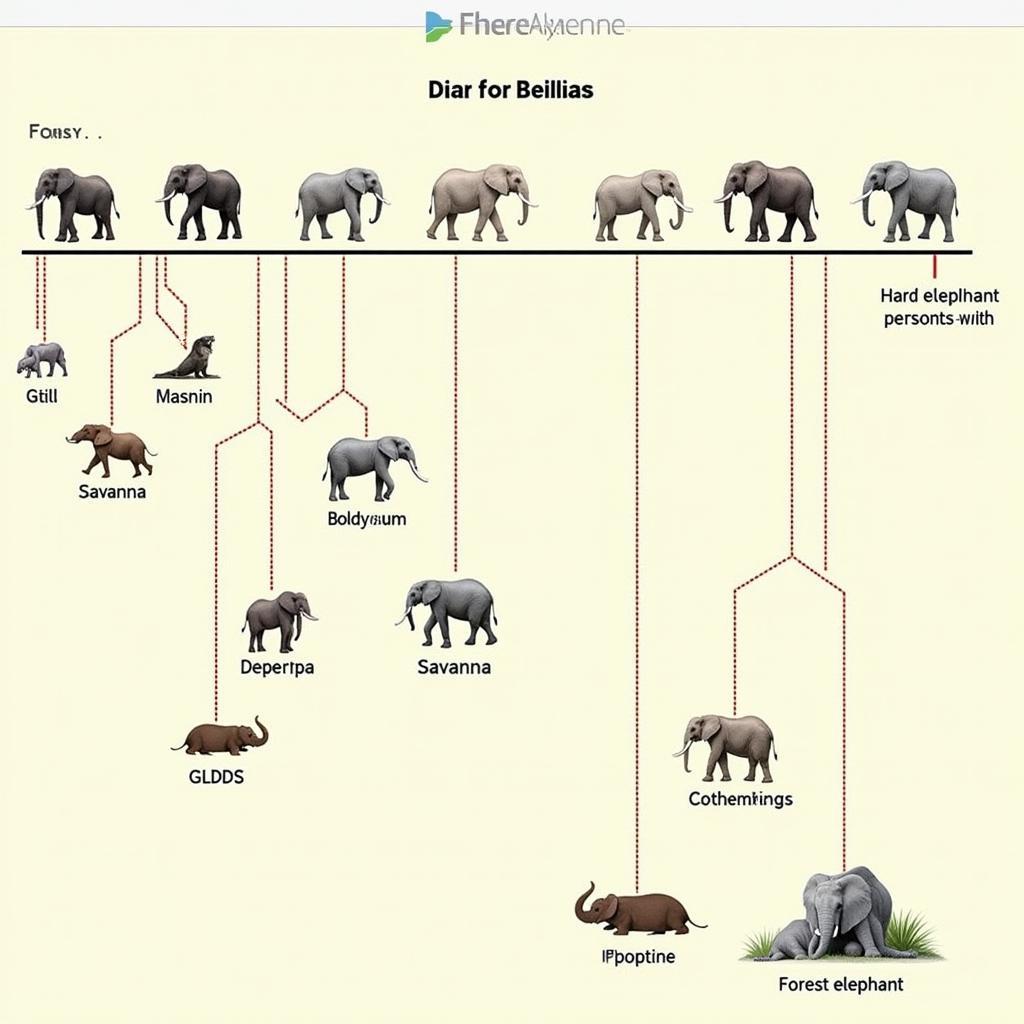African Elephant Species Name: A Comprehensive Guide
African elephants, iconic symbols of the continent, are not a monolithic group. Understanding the “African Elephant Species Name” requires delving into the fascinating world of these majestic creatures. This article will explore the two distinct species and the factors that differentiate them.
The African savanna elephant and the African forest elephant, while sharing a common ancestor, have evolved unique characteristics adapted to their respective habitats. This distinction, based on genetic, morphological, and ecological differences, is crucial for conservation efforts. Want to learn more about the incredible diversity of African wildlife? Check out the South African desert.
Decoding the African Elephant Species Name: Savanna vs. Forest
The two recognized species are Loxodonta africana (African savanna elephant) and Loxodonta cyclotis (African forest elephant). The savanna elephant, larger in size, roams the open grasslands, while the smaller forest elephant navigates the dense forests of Central and West Africa.
Key Differences Between the Two Species
- Size and Build: Savanna elephants are the largest land mammals, with larger ears and a concave back. Forest elephants are smaller, with straighter tusks and rounder ears.
- Habitat: Savanna elephants thrive in open grasslands and woodlands, while forest elephants inhabit dense rainforests.
- Diet: While both species are herbivores, their diets vary slightly based on available vegetation in their respective habitats.
- Social Structure: Forest elephants tend to live in smaller family groups than savanna elephants.
Understanding these differences is paramount for targeted conservation strategies. Each species faces unique threats and requires tailored approaches for their protection. Interested in learning more about other fascinating African animals? Discover the African animal kappa.
The Importance of Accurate Species Identification
Correctly identifying the African elephant species name isn’t just an academic exercise; it’s crucial for effective conservation. Population estimates, habitat management, and anti-poaching initiatives all rely on accurate species identification. Misclassification can lead to misallocation of resources and hinder conservation efforts.
Threats to African Elephants
Both species face significant threats, primarily from poaching for ivory and habitat loss due to human encroachment. These pressures necessitate focused conservation efforts to ensure the long-term survival of both species. You might also be interested in reading about the African huge elephant.
“Accurate species identification is the cornerstone of effective elephant conservation,” says Dr. Anika Moolman, a leading expert in African elephant research. “It allows us to understand the specific challenges faced by each species and develop targeted interventions.”
Genetic Insights into African Elephant Species
Recent genetic studies have further solidified the distinction between the two species, revealing millions of years of separate evolutionary history. This genetic evidence reinforces the importance of treating them as distinct conservation units.
The Evolutionary History of African Elephants
Fossil evidence and genetic analysis have provided valuable insights into the evolutionary history of African elephants, tracing their lineage back millions of years and highlighting their adaptation to diverse environments. Learn more about another majestic African creature, the African King Kobra.
 African Elephant Evolutionary Tree
African Elephant Evolutionary Tree
Conclusion: Preserving Both African Elephant Species
Understanding the “african elephant species name” is essential for ensuring the survival of these magnificent creatures. By recognizing and respecting the unique characteristics and challenges faced by both the savanna and forest elephant, we can contribute to effective conservation efforts and secure their future for generations to come. If you are planning a trip to Africa and want to explore its wildlife, consider contacting African Budget Safaris.
FAQ
- What are the two African elephant species? Loxodonta africana (African savanna elephant) and Loxodonta cyclotis (African forest elephant).
- What is the main difference in their appearance? Savanna elephants are larger with larger ears and a concave back, while forest elephants are smaller with straighter tusks and rounder ears.
- Where do they live? Savanna elephants live in open grasslands and woodlands, while forest elephants live in dense rainforests.
- Why is it important to know the different species? Accurate species identification is crucial for effective conservation efforts.
- What are the main threats to African elephants? Poaching for ivory and habitat loss due to human encroachment.
- How can I help protect African elephants? Support organizations dedicated to elephant conservation and raise awareness about the threats they face.
- What other resources can I consult to learn more? Numerous reputable websites and organizations provide valuable information on African elephants.
“Protecting both species requires a deep understanding of their unique needs and vulnerabilities,” adds Dr. Moolman. “By working together, we can ensure a future where both the savanna and forest elephant continue to thrive.”
For assistance, please contact us: Phone: +255768904061, Email: kaka.mag@gmail.com or visit us at: Mbarali DC Mawindi, Kangaga, Tanzania. We have a 24/7 customer support team.



